| Contributions to the theoretical understanding of the glass transition |
|---|
|
| Simulation of Nucleation and "Critical Clusters" |
|---|
|
| Simulation of Colloidal Systems under Confinement and Shear | |
|---|---|
 | In the framework of the transregional collaborative research center TR6 "Physics of colloidal dispersions in external fields" we study colloid-polymer mixtures confined in either slit pores or cylindrical pores, focusing on the interplay between finite size and surface effects on the possible phase separation between polymer-rich and colloid-rich phases, and on the structure of such systems under steady-state shear. In a variety of closely related subprojects, also the effects of confinement on one- or two-component colloidal crystals are studied, and the mechanical distortion of their struture caused by lateral compression, and the response of a dense colloidal dispersion is studied when one colloidal particle is dropped through the system ("microrheology"). Finally, also phase separation in mixtures of rodlike and spherical colloids is studied. For this research, we collaborate with J. Horbach (DLR Cologne), H. Löwen and S. Egelhaaf (University of Düsseldorf), P. Nielaba and G. Maret (University of Konstanz) and T. Schilling (University of Luxembourg). For more information, contact Kurt Binder and/or Peter Virnau. |
| Ising Models with Random Fields, with Gradients, Surface Fields, or Shear | |
|---|---|
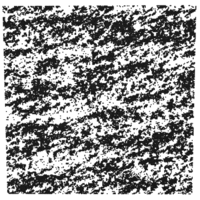 | While the Ising model is a kind of "fruitfly" of statistical mechanics, and its basic aspects are hence covered in all corresponding textbooks, for the development of Monte Carlo methods to study phase transitions the Ising model continues to be the major "workhorse", and thus continues to play an important role in the Condensed Matter Theory Group. In fact, this role is evident from two of the most well-known textbooks on Monte Carlo methods that have emerged from this group (D.P. Landau and K. Binder, A Guide to Monte Carlo Methods in Statistical Physics, 3rd ed.; Cambridge Univ. Univ. Press, Cambridge, 2009; K. Binder and D.W. Heermann, Monte Carlo Simulation in Statistical Physics. An Introduction. 5th ed.; Springer, Berlin, 2010), and from specific studies: e.g., the finite size scaling of the Ising model in random fields has been clarified; the phase transition of Ising films where surface fields compute with a field gradient in the bulk has been elucidated; the order parameter distribution of Ising strips or elongated tubes has been studied, to demonstrate the transition from single- domain to multiple-domain structure; finally, the anisotropic critical behavior of Ising systems under shear has been studied. Also methods to estimate wall free energies, contact angles of wall-attached droplets, line tensions, etc., have been first tested with the Ising model, before any attempt to use such methods for more complicated off-lattice models has been made. These studies have been part of a widespread collaborative effort, involving D. P. Landau (Center of Simulational Physics at the University of Georgia), E.V. Albano (University of La Plata/Argentina), and R.C.L. Vink (the University of Göttingen). For more information, please contact Kurt Binder and/or Peter Virnau. |
| Nonequilibrium Processes involving Single Macromolecules | |
|---|---|
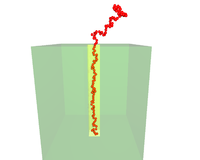 | In a biological context (e.g. DNA from a virus infects a cell by penetrating it through a pore of the cell membrane) it is of interest to study the dynamics of the conformational changes of single macromolecules under the action of external driving forces. Using coarse-grained models, phenomena such as the "escape transitions" of polymers or "forced translocation" of polymers through membranes are simulated. Even in the "thermodynamic limit" of infinite chain length counter-intuitive results such as inequivalence between different ensembles of statistical thermodynamics are found. This research is done in collaboration with A. M. Skvortsov (St. Petersburg), L. Klushin (American Univ. of Beirut) and A. Bhattacharya (Univ. Central Florida, Orlando). For more information, please contact Kurt Binder and/or Hsiao-Ping Hsu. |
| Bottle-Brush Polymers: From Tunable Stiffness to Intramolecular Phase Separation | |
|---|---|
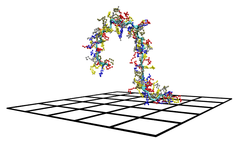 | A "bottle-brush" polymer consists of a long (flexible or semiflexible) backbone macromolecule, to which (at high grafting density) flexible side chains are anchored. Varying the length of these side chains, the stiffness of the resulting cylindrical object can be controlled. Monte Carlo simulations help to understand the interplay of the various length scales that describe the multiscale structure of these complex macromolecules, and contribute to the understanding of experiments perfomed at the Max Planck Institute for Polymer Research and the Institute for Physical Chemistry at the University of Mainz. Under poor solvent conditions, pearl-necklace type structures form, and if two types (A.B) of side chains are grafted, structures such a "Janus dumbbells" or "Janus cylinders" are predicted. This research is carried out in the framework of the collaborative research SFB 625 at Mainz, and in collaboration with W. Paul (University of Halle). For more information, please contact Kurt Binder and/or Hsiao-Ping Hsu. |
| Polymer Brushes on Flat and Curved Substrates | |
|---|---|
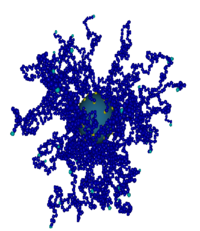 | A "polymer brush" is created if flexible macromolecules are anchored (via special endgroups) on a (otherwise repulsive) substrate at high grafting density, so the chains stretch away from the substrate to avoid that monomers sit on top of each other. We simulate such systems by Molecular Dynamics methods, both to elucidate their static structure, but also the nonequilibrium dynamic response as well as the interpenetration between two brush-coated nano-particles when two brushes are sheared against each other is studied. We interact on this topic with J. Klein (Weizmann Institute, Israel) and with T. Kreer and J. Baschnagel (Institute Charles Sadron, Strasbourg) and with A. Milchev (Bulgarian Academy of Sciences, Sofia) and S. Egorov (University of Virginia). For more information, please contact Kurt Binder and/or Federica Loverso. |
| Crystalline or Liquid-Crystalline Order in Polymeric Systems |
|---|
|
| The Interface between Graphite and Polybutadiene Melts: A Model System for a Polymer-Solid Contact |
|
|---|---|
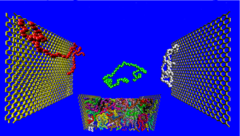 | In the framework of the priority program SPP 1369 "polymer-solid contacts" of the German Research Foundation (DFG) we simulate an atomistically realistic model for fluid polybutadiene confinded in a slit pore between two graphite walls, and study over which scale the walls modity structure and dynamics of the polymers, and characterize the resulting nanoscale "interphase" layers. These simulations require huge computer ressources and are done in collaboration with W. Paul of the University of Halle using the massively parallel JUGENE supercomputer at Jülich. For more information, please contact Kurt Binder and/or Peter Virnau. |
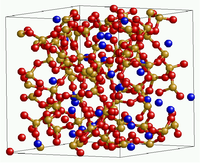 Understanding what causes the transition from undercooled fluids to glasses is one of the grand challenge problems of condensed matter physics, and for many years has been one of the main research topics of the Condensed Matter Theory Group at Mainz, and much of this research even has been condensed in a textbook (K. Binder and W. Kob, Glassy Materials and Disordered Solids: An Introduction to their Statistical Mechanics, 2nd ed., World Scientific, Singapore, 2010). Our recent work on this topic has focused on the analysis of the dynamics of probe molecules inserted as "reporters" into a glassforming matrix, a problem relevant to the analysis of single molecule spectroscopy experiments. This research is done in collaboration with R. Vallee (University of Bordeaux), W. Kob (University of Montpellier II), and W. Paul (Univ. Halle). For more information, please contact Kurt Binder.
Understanding what causes the transition from undercooled fluids to glasses is one of the grand challenge problems of condensed matter physics, and for many years has been one of the main research topics of the Condensed Matter Theory Group at Mainz, and much of this research even has been condensed in a textbook (K. Binder and W. Kob, Glassy Materials and Disordered Solids: An Introduction to their Statistical Mechanics, 2nd ed., World Scientific, Singapore, 2010). Our recent work on this topic has focused on the analysis of the dynamics of probe molecules inserted as "reporters" into a glassforming matrix, a problem relevant to the analysis of single molecule spectroscopy experiments. This research is done in collaboration with R. Vallee (University of Bordeaux), W. Kob (University of Montpellier II), and W. Paul (Univ. Halle). For more information, please contact Kurt Binder.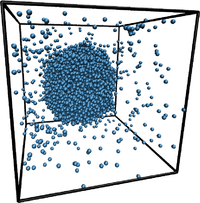 Metastable phases decay by rare statistical fluctuations, termed "nucleation", where a "critical cluster" (i.e., a nanoscopic aggregate of the new phase having the minimal size to be able to grow) forms. Such critical clusters may form in the bulk ("homogeneous nucleation"), which facilitate this cluster formation by reducing the free energy barrier that needs to be overcome. Specialized computer simulation methods are developed to estimate the surface excess free energies, that control these processes, and related quantities (such as contact angles, line tension, Tolman length). This research is carried out in the framework of the priority program SPP 1296 "Heterogeneous Nucleation and Structure Formation" of the German Research Foundation (DFG), and we collaborate with J. Horbach (DLR Cologne) and S. Egelhaaf and H. Löwen (University of Düsseldorf), where complementary studies are done, as well as with S. K. Das (Bangalore) and S. Puri (New Delhi, India). For more information, please contact
Metastable phases decay by rare statistical fluctuations, termed "nucleation", where a "critical cluster" (i.e., a nanoscopic aggregate of the new phase having the minimal size to be able to grow) forms. Such critical clusters may form in the bulk ("homogeneous nucleation"), which facilitate this cluster formation by reducing the free energy barrier that needs to be overcome. Specialized computer simulation methods are developed to estimate the surface excess free energies, that control these processes, and related quantities (such as contact angles, line tension, Tolman length). This research is carried out in the framework of the priority program SPP 1296 "Heterogeneous Nucleation and Structure Formation" of the German Research Foundation (DFG), and we collaborate with J. Horbach (DLR Cologne) and S. Egelhaaf and H. Löwen (University of Düsseldorf), where complementary studies are done, as well as with S. K. Das (Bangalore) and S. Puri (New Delhi, India). For more information, please contact 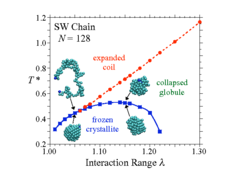 A single polymer chain in a poor solvent may collapse into a dense fluid globule, but it may instead also crystallize: By extensive simulations with the Wang-Landau algorithm we have shown that the crystal is favorable if the range of the attractive interactions between the monomers exceeds the range of the repulsions only slightly. These findings may be useful to understand scenarios for protein crystallization. The resulting structure is also modified when an attractive substrate surface is present, and/or when one considers a semiflexible rather than a flexible polymer: then liquid-crystal-line ordering comes into play. Single chains then may collapse forming torodial or plate-like strucutures, or lamellae attached to walls. Multichain systems, or semi-flexible polymers, however, are found to undergo isotropic to nematic transitions, similar to systems of hard rods. In the presence of confinement into thin films by hard walls, "capillary normalization" (i.e. wall-induced nematic order) is found. This research is carried out in collaboration with V. A. Ivanov (Moscow State University), J. Luettmer-Strathmann (The University of Akron), M. P. Taylor (Hiram College), and W. Paul (Martin Luther Universität Halle.) For more Information, please contact
A single polymer chain in a poor solvent may collapse into a dense fluid globule, but it may instead also crystallize: By extensive simulations with the Wang-Landau algorithm we have shown that the crystal is favorable if the range of the attractive interactions between the monomers exceeds the range of the repulsions only slightly. These findings may be useful to understand scenarios for protein crystallization. The resulting structure is also modified when an attractive substrate surface is present, and/or when one considers a semiflexible rather than a flexible polymer: then liquid-crystal-line ordering comes into play. Single chains then may collapse forming torodial or plate-like strucutures, or lamellae attached to walls. Multichain systems, or semi-flexible polymers, however, are found to undergo isotropic to nematic transitions, similar to systems of hard rods. In the presence of confinement into thin films by hard walls, "capillary normalization" (i.e. wall-induced nematic order) is found. This research is carried out in collaboration with V. A. Ivanov (Moscow State University), J. Luettmer-Strathmann (The University of Akron), M. P. Taylor (Hiram College), and W. Paul (Martin Luther Universität Halle.) For more Information, please contact